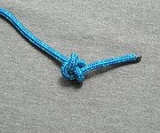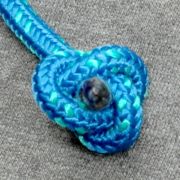
Ashley's stopper knot
Encyclopedia
Ashley's stopper knot, also known as the Oysterman's stopper, is a knot
developed by Clifford W. Ashley
around 1910. It makes a well-balanced trefoil-faced stopper
at the end of the rope, giving greater resistance to pulling through an opening than other common stoppers. Essentially, the knot is a common Overhand noose, but with the end of the rope passing through the noose eye, which closes upon it.
Ashley developed this knot in trying to duplicate a knot he saw on a boat in a local oyster
fishing fleet. When he had a chance to observe the knot up close at a later time he realized it was just a badly water-swollen figure eight stopper knot.


Knot
A knot is a method of fastening or securing linear material such as rope by tying or interweaving. It may consist of a length of one or several segments of rope, string, webbing, twine, strap, or even chain interwoven such that the line can bind to itself or to some other object—the "load"...
developed by Clifford W. Ashley
Clifford Ashley
Clifford Warren Ashley was an American artist, author, sailor, and knot expert. He was born in New Bedford, Massachusetts, son of Abiel Davis Ashley and Caroline Morse. Ashley married Sarah Scudder Clark in 1932 and had two daughters, also adopting his wife's oldest daughter from a previous...
around 1910. It makes a well-balanced trefoil-faced stopper
Stopper (knot)
The term stopper knot has three distinct meanings in the context of knotting and cordage.-At the end of a line:A stopper knot is tied at the end of a rope to prevent the end from unraveling, slipping through another knot, or passing back through a hole, block, or belay/rappel device...
at the end of the rope, giving greater resistance to pulling through an opening than other common stoppers. Essentially, the knot is a common Overhand noose, but with the end of the rope passing through the noose eye, which closes upon it.
Ashley developed this knot in trying to duplicate a knot he saw on a boat in a local oyster
Oyster
The word oyster is used as a common name for a number of distinct groups of bivalve molluscs which live in marine or brackish habitats. The valves are highly calcified....
fishing fleet. When he had a chance to observe the knot up close at a later time he realized it was just a badly water-swollen figure eight stopper knot.
Tying


- Form an Overhand noose, or simply tie an overhand knotOverhand knotThe overhand knot is one of the most fundamental knots and forms the basis of many others including the simple noose, overhand loop, angler's loop, reef knot, fisherman's knot and water knot. The overhand knot is very secure, to the point of jamming badly. It should be used if the knot is...
around the standing part as shown. - Tighten the overhand portion of the knot around the standing part. Thread the working part through the loop.
- First close the noose on the working part by pulling on the standing part, then remove any remaining slack in the knot by pulling on the working part. The knot should have a tidy, triangular shape where the standing part enters the knot. (See image at right.)

